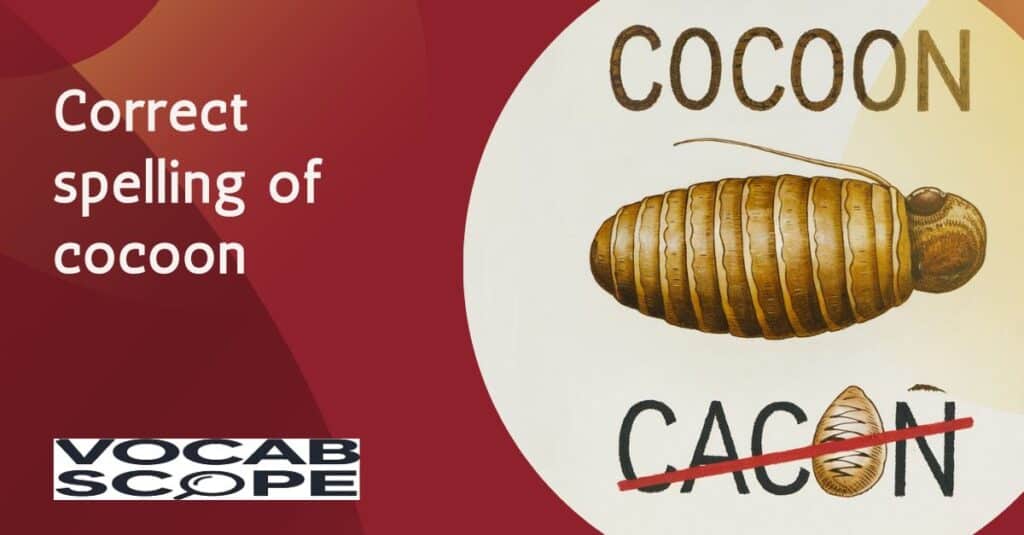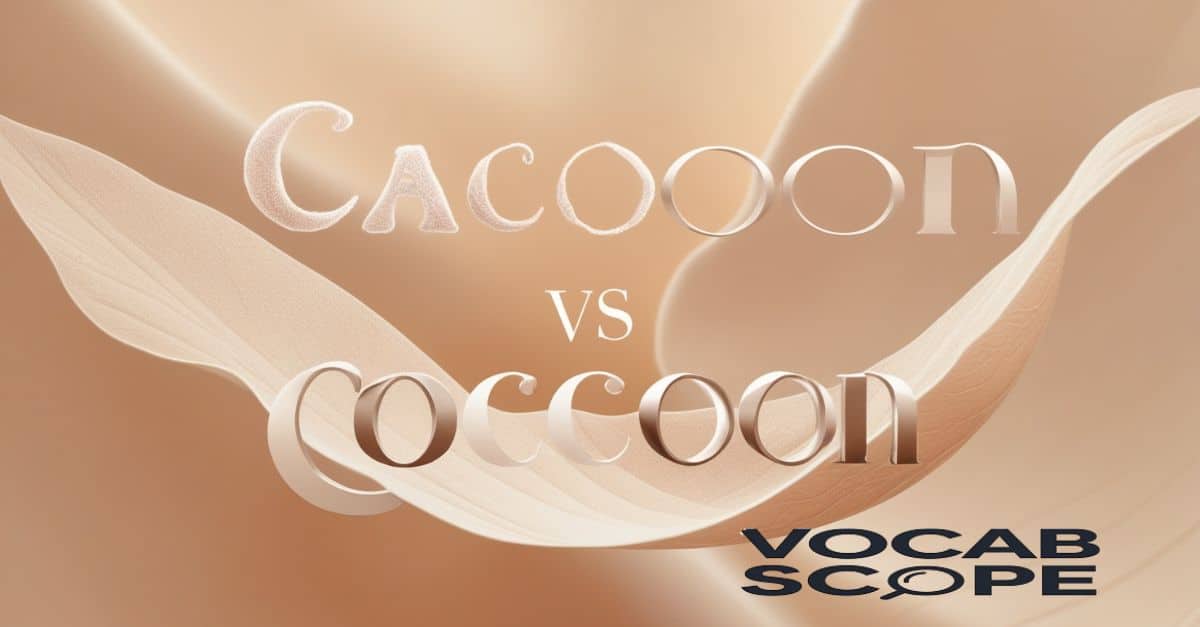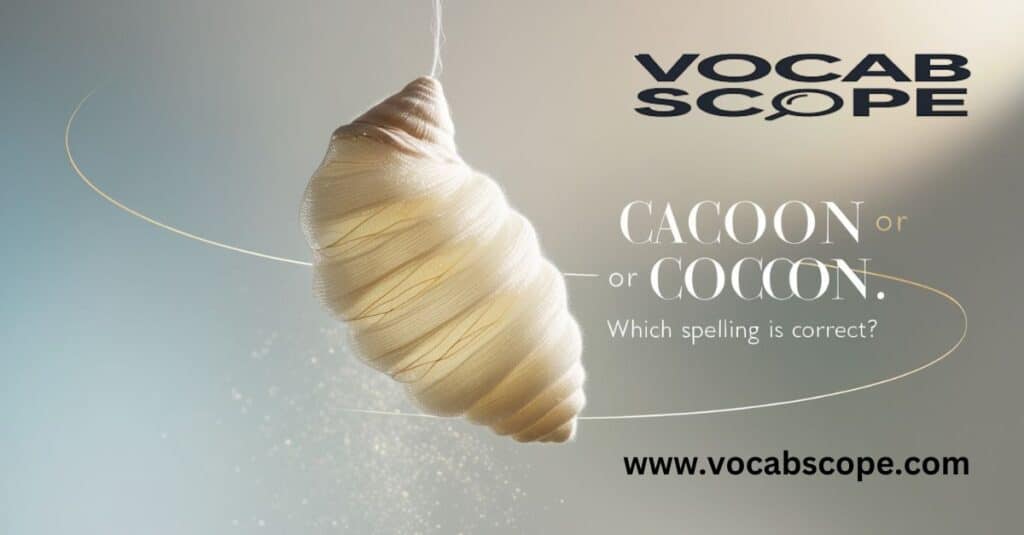English spelling can often be perplexing, and one common point of confusion is the choice between “cacoon” and “cocoon.” While these two spellings might seem similar, only one is correct.
Understanding the proper usage of cocoon is essential for accuracy in writing. Using the correct spelling ensures that you convey the right meaning in various contexts, maintaining both clarity and professionalism.
Common Spelling Confusion
Spelling confusion often arises from how words sound versus how they are written. The “cocoon” spelling is sometimes confused with “cacoon” due to the similarity in pronunciation. English is replete with such spelling confusions where phonetics can lead to errors.
What is A “Cacoon”?

“Cacoon” isn’t actually a real word. It’s just a mistake people sometimes make when they’re trying to spell “cocoon”. You might see it written this way now and then, but it’s not correct.
If you see “cacoon” in something you’re reading, the writer probably meant to say “cocoon“. A cocoon is that silky bag some insects make to protect themselves while they change into their adult form. Butterflies are famous for making cocoons.
What is a “Cocoon”?

“Cocoon” is the right way to spell this word. It has two O’s in the middle, not an A. Some people might think it’s spelled “cacoon,” but that’s not correct. When you’re writing about those silky bug homes, remember it’s C-O-C-O-O-N.
If you’re not sure how to spell it, think of two eyes in the middle of the word. The two O’s look like eyes! Or you can remember that cocoons are cozy, and both “cocoon” and “cozy” start with “co“. Spelling can be tricky, but now you know the right way to spell this cool bug word.
Cacoon vs. Cocoon: The Correct Spelling
The correct spelling is “cocoon“. This word refers to the protective covering that certain insect larvae, particularly caterpillars, create around themselves before undergoing metamorphosis into their adult form. The term “cocoon” can also be used metaphorically to describe a state of protection or isolation.
“Cacoon” is a common misspelling of the word. Despite its occasional appearance in informal writing or casual usage, it is not recognized as a standard spelling in any English dictionary. When writing, it’s important to use the correct form, “cocoon,” to ensure clarity and maintain proper language conventions.
“Cacoon” vs “Cocoon”: The Differences

“Cacoon” is a common misspelling, while “cocoon” is the correct term for a protective covering made by insects or a metaphor for a safe, sheltered place.
Spelling:
- Cocoon: The correct spelling for an insect’s protective case or a metaphorical safe space.
- Cacoon: A rare botanical term referring to a type of tropical climbing plant in the genus Entada.
Meaning:
- Cocoon: A protective silk case spun by insects for metamorphosis; metaphorically, any safe, sheltered environment fostering growth or change.
- Cacoon: The large, spherical fruit of the Fevillea cordifolia vine, native to tropical America, used in traditional medicine and crafts.
Usage:
- Cocoon: Commonly used in biology, entomology, and everyday language to describe protective enclosures or periods of transformation in various contexts.
- Cacoon: A specialized term primarily used in botany and ethnobotany, occasionally appearing in discussions of Caribbean and South American flora or traditional medicine.
Synonyms for Cocoon:
- Enclosure
- Case
- Shell
- Covering
- Chrysalis
- Wrap
- Nest
- Protective layer
- Sheath
- Shield
Synonyms for Cacoon:
Since cacoon is generally not considered correct, its synonym would be the same as cocoon.
You Will Like: totalling-or-totaling-which-spelling-to-use
Common Mistakes with Cocoon Spelling
One common error is substituting “cacoon” for “cocoon.” This mistake often arises from phonetic similarity. The mispronunciation of “cocoon” as “cacoon” can lead to spelling confusion.
Here’s a table showing the differences:
| Aspect | Cocoon | Cacoon |
| Correct Spelling | Cocoon | Cacoon (Incorrect) |
| Meaning | Protective casing for insects | Nonexistent term |
| Usage Example | “The butterfly emerged from its cocoon.” | “The butterfly emerged from its cacoon.” (Incorrect) |
Examples of “Cacoon” and “Cocoon” in Context
Cacoon in Context:
- The cacoon vine draped elegantly over the trellis, its vibrant green pods hanging like ornaments.
- As the cacoon matured, it hardened into a glossy shell, protecting the precious seeds within.
- In many indigenous communities, the cacoon is crafted into musical instruments used in traditional ceremonies.
- The cacoon tree thrives in coastal regions, where its pods are often harvested for their dense, fibrous material.
- Known for its resilience, the cacoon bean can withstand extreme weather conditions, making it a symbol of endurance.
- Artisans in rural villages use the cacoon’s smooth surface as a canvas for intricate, hand-painted designs.
- The cacoon fruit is believed to have spiritual significance, symbolizing renewal and protection in many tropical cultures.
- When split open, the cacoon reveals seeds that are often used in folk remedies and natural dyes.
- Researchers are studying the cacoon’s unique chemical composition for potential use in eco-friendly products.
- Unlike other tropical plants, the cacoon’s distinct growth pattern allows it to flourish even in nutrient-poor soils.
Cocoon in Context:
- She wrapped herself in the cocoon of a soft quilt, blocking out the world as the rain drummed against the window.
- As autumn approached, the trees seemed to cocoon themselves in a blanket of golden leaves.
- The delicate silk cocoon shimmered under the microscope, revealing the intricate fibers woven by the silkworm.
- His favorite part of the day was retreating into his cocoon-like study, surrounded by books and silence.
- The transformation inside the cocoon is a fascinating example of nature’s marvels, turning a simple caterpillar into a graceful butterfly.
- Encased in the cocoon of a plush velvet armchair, she found solace in the pages of her novel.
- The cocoon represents a quiet pause, a moment of stillness before life bursts forth in a new form.
- He decided to cocoon himself in the comforts of his home office, avoiding the hustle of the outside world.
- The artist described her work as a cocoon of ideas, slowly unraveling into vibrant, visual expressions.
- The concept of cocooning, in interior design, is all about creating intimate, enveloping spaces that feel safe and serene.
Usage in Sentences
Here’s how to correctly use cocoon in sentences:
- “The caterpillar spun a cocoon to protect itself during its transformation.”
- “She found comfort in her personal cocoon after a long day.”
In contrast, using “cacoon” would be incorrect:
- “The caterpillar spun a cacoon during its transformation.” (Incorrect)
- “She found comfort in her personal cacoon.” (Incorrect)
Origins of “Cacoon” and “Cocoon”
Origins of “Cocoon”
The words “cacoon” and “cocoon” have different origins, though “cacoon” is often considered a common misspelling of “cocoon.” The word “cocoon” comes from the French word cocon, meaning “shell.” It originally referred to the silky casing spun by insects like caterpillars to protect themselves during the pupal stage.
Origins of “Cacoon”
The word “cacoon” is not widely recognized in formal language and might appear as a typo or regional variant. However, “cocoon” has been used in English since the 17th century and is commonly associated with protection or a place of transformation, not just for insects but in a metaphorical sense as well.
Why Cocoon is the Correct Spelling
The term cocoon is derived from the Latin word coconus, which refers to a protective case made of silk by certain insects. This word has evolved into English, retaining its original spelling and meaning.
Using the term cocoon correctly ensures that your writing is accurate. Misusing “cacoon” might confuse readers or suggest a lack of attention to detail. It’s important to adhere to proper spelling conventions to maintain credibility in your writing.
Practical Examples of Cocoon in Sentences
Using the correct spelling in sentences is key to clear communication. Here are practical examples:
“The caterpillar spun a cocoon to safely transition into a butterfly.”
“Her new apartment felt like a cozy cocoon after a long day.”
These examples illustrate how cocoon is used correctly to describe both a physical structure and a metaphorical space.
Tips for Remembering Cocoon’s Spelling
To avoid spelling mistakes, consider these tips:
- Associate the Double “O”: Visualize the round shape of a cocoon to remember the double “o” in cocoon.
- Phonetic Reminder: Remember that despite the sound, the correct spelling is cocoon and not “cacoon.”
Cocoon in Everyday Language
In everyday language, cocoon has been adopted to describe anything that provides a sense of comfort. This includes items like cozy furniture or secure environments.
For example, a cocoon chair refers to a chair designed to offer a comfortable, enveloping experience. This use reflects the original idea of a cocoon as a space of protection and comfort.
Conclusion
Mastering the correct spelling of cocoon and understanding its meanings is essential for clear and accurate communication. Whether discussing the protective casing of insects or using it metaphorically to describe a cozy, safe space, using the term cocoon correctly reflects both your attention to detail and your grasp of its diverse uses.
By recognizing and addressing spelling confusion and appreciating the word’s application in various contexts, you can enhance your writing and ensure that your message is conveyed accurately and effectively.

“Robert Henry is an experienced blogger with a passion for language and education. His insightful posts on Vocab Scope offer readers valuable tips on vocabulary and grammar. With a background in linguistics and a knack for clear, engaging writing, Robert is dedicated to helping others enhance their communication skills.”






